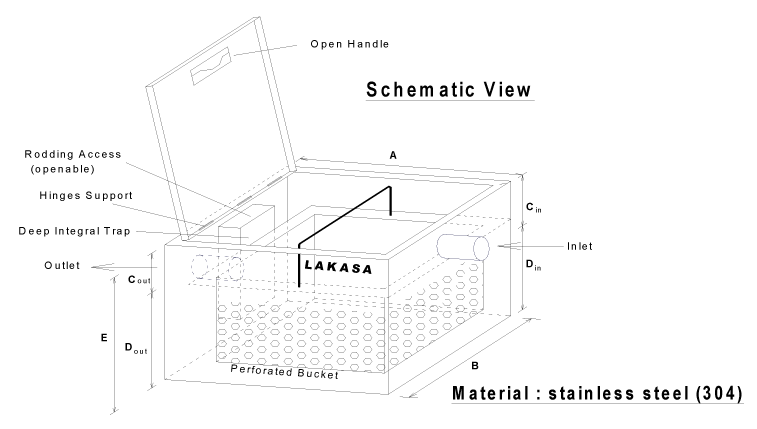References
LAKASA Sediment Interceptor
LAKASA Sediment Interceptor is completed with a perforated bucket and able to act as an effective strainer to avoid drain lines clogging by foreign solid particles. The perforated bucket should be cleaned on daily basis or as frequent as possible to avoid overflow of solid waste and interrupting free flow of wastewater in the drain lines.
The system must be of adequate size and design to intercept the incoming solid particles and also taking into consideration the periodic cleaning schedule requirements. The sediment waste should be cleaned as soon as it is filled up half full. It can be daily or once every 3-4 days, depending on the volume of sediment waste.
Installation method statement
- Inspect unit for defects / damages and make sure it meets specified requirements (eg : model and size).
- DO NOT INSTALL INTERCEPTOR BACKWARDS. Install interceptor as close as possible to the source to minimizes unprotected pipe.
Install interceptor sitting on floor, partially recessed or flush-to-floor, making sure there is enough room to allow for easy maintenance of the unit. (Room for cover to be removed and sediment bucket to be taken out for cleaning). - INTERCEPTOR MUST BE PLACED ON A FLAT, SOLID SURFACE TO SUPPORT THE BOTTOM! When suspending interceptor from floor above, all units must be fully supported on bottom with a flat surface strong enough to support the weight of the unit when full of water/sediment waste. All units must be independently supported to avoid stress on fittings.
- WHEN INSTALLING IN THE GROUND, Construct a solid manhole sump for housing the interceptor. Manhole sump cover should normally be higher a bit the floor level OR construct a drain surrounding the cover to channel away most rain water and prevent in from entering the sump. The sump should also allocate four corner Water Exit at lowest possible 4 sides corners for the in case splashed into rain water to escape and seep into the earth outside the sump.
- FILL INTERCEPTOR WITH WATER AND INSTALL LID BEFORE BACK FILLING. It is recommended to use light sand for back fill. Be sure backfill is free of sharp stones and foreign matter to avoid punctures. (DO NOT PUT SAND INTO INTEREPTOR!)
- INTERCEPTOR filled with clean water until static water level and is ready for operation.

Dimensional Data
Various dimensions is available upon request or to suit site requirement
| Model | Pipe Size
(mm) |
A
(mm) |
B
(mm) |
C in
(mm) |
C out
(mm) |
D in
(mm) |
D out
(mm) |
E
(mm) |
| LKS 9222 | 50 | 200 | 200 | 70 | 100 | 130 | 100 | 200 |
| LKS 9333 | 50 | 300 | 300 | 100 | 200 | 200 | 100 | 300 |
| LKS 9434 | 75 | 400 | 400 | 100 | 200 | 200 | 100 | 300 |
| LKS 9545 | 100 | 500 | 500 | 110 | 250 | 290 | 150 | 400 |
| LKS 9656 | 100 | 600 | 600 | 120 | 300 | 380 | 200 | 500 |
| LKS 9767 | 100 | 700 | 700 | 120 | 300 | 480 | 300 | 600 |
| LKS 9878 | 100 | 800 | 800 | 130 | 350 | 570 | 350 | 700 |